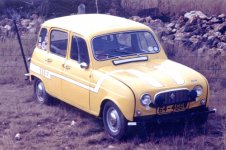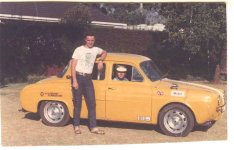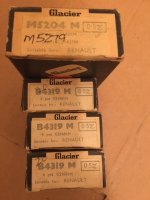The Renault manuals nominate a maximum removal of 1/2mm from Ventoux cylinder heads. While that's no doubt conservative, 1/8'' would be very risky. The problem is the bottom 'deck' of the head is fairly thin. While it is stiffened by the vertical walls of the combustion chamber, that leaves sections of the liner periphery relatively unsupported. I'm a coward - I removed 1mm and wasn't game to go further!Hi Stan
You are over-thinking thislooking under the bed for boogey men. Extra CCs are good, no down side really. (except cost ?) Forget about valve shrouding and air flow etc etc that is all BS in this circumstance. If you can clean a few casting dags and match the manifolds better and even clean out the valve ports a bit, it will feel good. If not then just settle for the 7%. Shave the head while it is off to get the compression up to a modern figure. You might have to retard the ignition because the engine runs so much better as the combustion is faster.
In times past on old Citroens I just asked for 1/8" off the head. No down side ! I probably shaved a few 750 heads too but forget now. They were meaty thick alloy castings if they are not corroded badly. Gees the difference the good coolants made there. The R4 was an early model with a 750 engine and the head was just the same as the 750 heads as I remember ! I put a hot cam in that too but it was really too wild for a 3 speed and front wheel drive, but a small cam would be good too !
Back in the good ol'days, say about 1965, we had a 750 we acquired from somewhere and drove it around a newly laid out subdivision with dirt roads behind my mates place. Heaven sliding it around till somebody rolled it. So we went and cut the roof off with a can opener and a hacksaw on the pillars and frame members. Left the doors on "for safety" as no belts in those days. I think we rigged up a can and hose so "no one else could drive it", and had to tie the center pillars together with a rope to hold the doors from drooping when openedThat kept going for quite a while till it just disappeared one day. Ahh well, easy come, easy go !
We had earlier (or later) done a similar thing with a Fiat 500 Toppolino fitted with a Triumph 500 twin motor. It was fun for a while 'up the back' of another mates place. Then he came home one day and a dozer had cleared the area and dug a big hole for the rubbish and made it all go away, before the subdivision started.Bugger !
Hmm had a Honda 50 step thru that did good service for a long while through the bush again. My mates wife was the quickest till she found out it had brakes.When the bike fell apart I fitted the motor to an old kart frame for my kids to drive around. Not a bad unit for a freebee either. I wonder where that went in the end ?
Cheers Jaahn

You are using an out of date browser. It may not display this or other websites correctly.
You should upgrade or use an alternative browser.
You should upgrade or use an alternative browser.
1959 4cv Restoration in North Carolina USA
- Thread starter Stan W
- Start date
Stan,
There is a lot of hidden power in a Dauphine motor.

This is a R4 version, that was built on the basis of a Dauph 850 before, that ran in my Dauphine.
The head was the most important part of the project. The inlet ports were 32mm diam, the exhausts were 25mm diam. The head was skimmed 2.5mm and combustion chambers were opened up to unshrowd valves. And made to work at 9.8:1 CR to run on regular leaded fuel. Inlet valves were "Gordini racing", 1.2mm bigger exhausts were standard. Valve springs were "Gordini racing" doubles. But found out later outers were standard Dauph, and inners were same as a Honda motorcycle inner, cannot remember what model. Cam was a Alconi 701, ground forward on earlier Dauph motor and reversed on R4 motor, 267 deg duration 6.3mm lift. Would rev to 6000 but red lined to 5800RPM as ran out of torque there. Conn rods were Gordini, fully polished, and balanced as was pistons. Crank was fully radiased edges, fully polished surfaces, and balanced. And was brand new before starting (no cracks). R4 had modified block to run external oil filter and cooler. Both motors used a aluminium idler gear for cam drive. Both motor ran a twin choke Solex from a Diahutsu 1000, I think a 26/18, with spring actuated second choke.
Both the cars were faster than a 1600 Mk1 Golf up to about 100-105 Kph, then they would pass me, at the right traffic lights they would have to slow before they passed me. Motors did 35K mile for Dauph and 82Kmiles on R4 without being opened.
There is a lot of hidden power in a Dauphine motor.
This is a R4 version, that was built on the basis of a Dauph 850 before, that ran in my Dauphine.
The head was the most important part of the project. The inlet ports were 32mm diam, the exhausts were 25mm diam. The head was skimmed 2.5mm and combustion chambers were opened up to unshrowd valves. And made to work at 9.8:1 CR to run on regular leaded fuel. Inlet valves were "Gordini racing", 1.2mm bigger exhausts were standard. Valve springs were "Gordini racing" doubles. But found out later outers were standard Dauph, and inners were same as a Honda motorcycle inner, cannot remember what model. Cam was a Alconi 701, ground forward on earlier Dauph motor and reversed on R4 motor, 267 deg duration 6.3mm lift. Would rev to 6000 but red lined to 5800RPM as ran out of torque there. Conn rods were Gordini, fully polished, and balanced as was pistons. Crank was fully radiased edges, fully polished surfaces, and balanced. And was brand new before starting (no cracks). R4 had modified block to run external oil filter and cooler. Both motors used a aluminium idler gear for cam drive. Both motor ran a twin choke Solex from a Diahutsu 1000, I think a 26/18, with spring actuated second choke.
Both the cars were faster than a 1600 Mk1 Golf up to about 100-105 Kph, then they would pass me, at the right traffic lights they would have to slow before they passed me. Motors did 35K mile for Dauph and 82Kmiles on R4 without being opened.
Attachments
We ran a modified Dauphine engine in a home made race car 1962 - 64. It ran easily to 6000 rpm and higher. Tacho scale stopped at 6000. The head was from a R1063 race car as was the cam. The head had 3 mm skimmed off it and there was no shrouds and the square edge inside the combustion chamber was rounded off. The twin valve springs were off the 1063. I believe the inner from a Mini of some sort. The compression ratio was 11 or more and the motor was only happy with avgas 110 or super fuel with methanol added. The tappet gear was all lightened and the springs separating the tappets were replaced with spacers. The head had been ported but I no longer remember sizes. It ran twin inch eighth SU carbs that were not big enough and should have been inch and a quarter. Crank was standard but polished. The centre main bearing was strengthened with a 12 mm thick mild steel block held with 2 head bolts. The rods were standard but lightened, polished and balanced. The mistake was to cut too much off the piston skirts and therefore ran only about 150 racing kilometres before breaking top rings. The 3 speed gearbox was useless with that cam, the process was run to valve bounce, change gear and hope it didn't bog down too much. It needed a 4 speed or the 5 speed from the 1063 that I couldn't afford. The gearbox was tipped over to lower the engine height. Some had to be ground off the teeth of the crown wheel to allow that. Back then open exhausts were allowed and we ran 4 separate exhaust pipes to a tuned length. A Dauphine or 4CV engine can be made to perform very well and are really very tough.
Wow great stories from the good ol'days 
 Should be moved/copied to a thread of their own so they are searchable in the future !!
Should be moved/copied to a thread of their own so they are searchable in the future !!
Those little motors were tough and made to last so could take a flogging. I certainly tried hard. I have another story for later about that.
I spent some time at work 'in slow work times' with a spare head hacking out the ports to see what you could do and generally destroying it for the sake of science They were meaty castings !!
They were meaty castings !!
Hey Sunroof where did you get the 1093 motor parts. They were the 'holy grail' of Renault stuff and made hens teeth look easy to find ??? Murry Bingham had one that I looked at with interest. It was taken from the car, for racing in his special hill climb car for a while, and my mate got the car fitted with an 1108 R8 motor. There was a 5 speed set of gears around too but who knows where they went.
Murry Bingham had one that I looked at with interest. It was taken from the car, for racing in his special hill climb car for a while, and my mate got the car fitted with an 1108 R8 motor. There was a 5 speed set of gears around too but who knows where they went.
Jaahn
Those little motors were tough and made to last so could take a flogging. I certainly tried hard. I have another story for later about that.
I spent some time at work 'in slow work times' with a spare head hacking out the ports to see what you could do and generally destroying it for the sake of science
Hey Sunroof where did you get the 1093 motor parts. They were the 'holy grail' of Renault stuff and made hens teeth look easy to find ???
Jaahn
We know one R1063 was definitely imported and crashed in Oz. There's a correct gearbox with an enthusiast in Geelong and Mr Sunroof had engine parts. Norm Wray had one, maybe the same one, in Melbourne. There doesn't seem much more known in summary but I always hope more will be flushed out.......Wow great stories from the good ol'daysShould be moved/copied to a thread of their own so they are searchable in the future !!
Those little motors were tough and made to last so could take a flogging. I certainly tried hard. I have another story for later about that.
I spent some time at work 'in slow work times' with a spare head hacking out the ports to see what you could do and generally destroying it for the sake of scienceThey were meaty castings !!
Hey Sunroof where did you get the 1093 motor parts. They were the 'holy grail' of Renault stuff and made hens teeth look easy to find ???Murry Bingham had one that I looked at with interest. It was taken from the car, for racing in his special hill climb car for a while, and my mate got the car fitted with an 1108 R8 motor. There was a 5 speed set of gears around too but who knows where they went.
Jaahn
I have a scheme one day to get Messrs Geckoeng and Harrisonati together for a chat. Perhaps 2022... You won't know this Stan but they live on opposite sides of the country!Stan,
There is a lot of hidden power in a Dauphine motor.
View attachment 129520
This is a R4 version, that was built on the basis of a Dauph 850 before, that ran in my Dauphine.
The head was the most important part of the project. The inlet ports were 32mm diam, the exhausts were 25mm diam. The head was skimmed 2.5mm and combustion chambers were opened up to unshrowd valves. And made to work at 9.8:1 CR to run on regular leaded fuel. Inlet valves were "Gordini racing", 1.2mm bigger exhausts were standard. Valve springs were "Gordini racing" doubles. But found out later outers were standard Dauph, and inners were same as a Honda motorcycle inner, cannot remember what model. Cam was a Alconi 701, ground forward on earlier Dauph motor and reversed on R4 motor, 267 deg duration 6.3mm lift. Would rev to 6000 but red lined to 5800RPM as ran out of torque there. Conn rods were Gordini, fully polished, and balanced as was pistons. Crank was fully radiased edges, fully polished surfaces, and balanced. And was brand new before starting (no cracks). R4 had modified block to run external oil filter and cooler. Both motors used a aluminium idler gear for cam drive. Both motor ran a twin choke Solex from a Diahutsu 1000, I think a 26/18, with spring actuated second choke.
Both the cars were faster than a 1600 Mk1 Golf up to about 100-105 Kph, then they would pass me, at the right traffic lights they would have to slow before they passed me. Motors did 35K mile for Dauph and 82Kmiles on R4 without being opened.
I reckon the distance the Geckoeng motors travelled without problems says a lot. I'll bet they weren't mollycoddled when driven.
I believe that there was at least 3 R1063 in Australia. (I am told they shouldn't have an R in front of the number.) A Bris local ran one when he lived in Canberra, he said there was one in NSW he knew of at the same time racing at Eastern Creek, and the crashed one in Victoria. It was the crashed one I got the bits from. Norm Wray had one that may have been another altogether. There is at least two or three 5 speed gearboxes around still. But a 4 speed Dauphine box is said to be equally quick as the 5 speed crash box. The crash box was difficult to use apparently. Sorry Stan for hijacking your thread.
Thanks for that. I guess the "crashed one" might be the one advertised back in the day as running at races held at Fisherman's Bend, Melbourne. Strictly, they are "dog boxes" aren't they? Constant mesh - Norm's wife certainly complained about the gearbox when taking the kids to school, it is said..... Maybe the gearbox in Geelong is the one from the crashed car? Who knows. Bit late to chase these details.I believe that there was at least 3 R1063 in Australia. (I am told they shouldn't have an R in front of the number.) A Bris local ran one when he lived in Canberra, he said there was one in NSW he knew of at the same time racing at Eastern Creek, and the crashed one in Victoria. It was the crashed one I got the bits from. Norm Wray had one that may have been another altogether. There is at least two or three 5 speed gearboxes around still. But a 4 speed Dauphine box is said to be equally quick as the 5 speed crash box. The crash box was difficult to use apparently. Sorry Stan for hijacking your thread.
The books on the subject do omit the "R" I think. Given they only made 80, getting 3-4 to Oz is amazing, although some might have been "kitee" cars I guess.
Sorry Stan, but it is interesting!
They were not from the original 80 and were therefore kitee cars. But the problem seems to be who made them. They were advertised by Pound Motors at least. They were also made very late in the piece 1955 or 56 I seem to remember. Although one may have been imported from the 80 as some cannot be accounted for however they would have been lefthand drive I would imagine. They were said to be imported in the advertisement in fact I think they were advertised prior to arriving in Australia. So who in France would have got right hand drive cars and then added the kitee parts? Perhaps the UK factory but if so why not sell them in UK as well? The Bris owner thinks his car said 1063 on the oval plate.
They did make RHD cars in France (mine is), so an assembly line kitee 1063 is perhaps possible? Some were made on the assembly line and some modified afterwards as SAPRAR sold the parts. Wish we knew a wee bit more.... Must check my list of 1063 cars....They were not from the original 80 and were therefore kitee cars. But the problem seems to be who made them. They were advertised by Pound Motors at least. They were also made very late in the piece 1955 or 56 I seem to remember. Although one may have been imported from the 80 as some cannot be accounted for however they would have been lefthand drive I would imagine. They were said to be imported in the advertisement in fact I think they were advertised prior to arriving in Australia. So who in France would have got right hand drive cars and then added the kitee parts? Perhaps the UK factory but if so why not sell them in UK as well? The Bris owner thinks his car said 1063 on the oval plate.
Very interesting information! There was a thread somewhere else about a real 1093 still in California - stuck in the shed of an old recluse. This may sound disappointing, but I am sticking with 58mm cylinders, mostly due to cost. Head gaskets have already been mentioned. My engine will be similar to a US spec 1960 Dauphine which had 8:1 compression resulting in 32 hp. Based on information from various sources, the autobleu manifold might add another 1.5 to 2 hp. The head appears to have been shaved .5 mm, and may get another .005 inches shaved. This will give slightly higher compression and might add another 2 hp. The end result might be 35 to 36 hp, which is quite respectable for a 4cv. The stock cam will give very good mid to low range torque, resulting in good driveability. I have an appropriate Dauphine story , but I will create another thread for that. I have been working on a really important part - the shifter knob. It is made from 125 year old black walnut and is the correct size and shape. I don't have a lathe, but I do have a table saw, belt sander and drill press.
, but I will create another thread for that. I have been working on a really important part - the shifter knob. It is made from 125 year old black walnut and is the correct size and shape. I don't have a lathe, but I do have a table saw, belt sander and drill press.
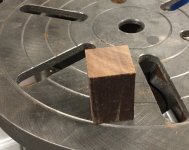
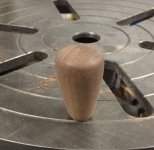
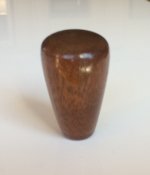



Back to the air filter.... I carefully drilled out the welds holding the wire cone assembly without making holes in the filter top piece. I could go to one of the local auto parts stores and find a filter that would fit, there should be quite a few. I have an extra filter for my riding lawn mower and it fits well. Any reason not to use it in the 4cv? The outer foam piece is a washable pre-filter.
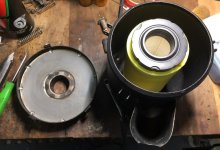
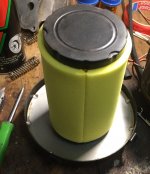


LOOKS GOOD TO ME you could try removing and replacing it when the motor is running to see if it causes any restriction ,keeep an eye on plug colour after driveing for a while .
Looks good to me, don't forget to use some air filter oil on the foam and also make sure you squeeze out all the excess oil.Back to the air filter.... I carefully drilled out the welds holding the wire cone assembly without making holes in the filter top piece. I could go to one of the local auto parts stores and find a filter that would fit, there should be quite a few. I have an extra filter for my riding lawn mower and it fits well. Any reason not to use it in the 4cv? The outer foam piece is a washable pre-filter.
View attachment 129580View attachment 129581
There's a trade-off of filter efficiency against restriction. With my Dauphine, the engine compartment becomes 'top-dressed' in dust after a session on dirt roads. Fortunately, it has a 'colonial specification' air intake in the boot, so hardly any dust reaches the air filters. I assume that your US spec. car doesn't have that set up, so the filter(s?) need to cope with whatever dust is thrown up by the front wheels.
If you intend to drive only on paved surfaces, I would just use a low-restriction paper element filter, like the one in your photo, but without the foam pre-filter. The foam pre-filter is often used on mowers to prevent filter 'blinding' with grass and other coarse matter. The fine filtration is done in the filter element below. Oiling the pre-filter improves efficiency but creates restriction.
However, if you do intend to drive on un-paved roads, go for the highest level of filtration you can organise!
If you intend to drive only on paved surfaces, I would just use a low-restriction paper element filter, like the one in your photo, but without the foam pre-filter. The foam pre-filter is often used on mowers to prevent filter 'blinding' with grass and other coarse matter. The fine filtration is done in the filter element below. Oiling the pre-filter improves efficiency but creates restriction.
However, if you do intend to drive on un-paved roads, go for the highest level of filtration you can organise!
I just use a modern paper element inside the original louvred air filter housing beside the engine. Dirt roads certainly throw dust at the air cleaner, and back in early days, before I knew about these things, the car would fill the filter housing with fine dust to the point of stalling the engine. You could see the dust inside the carburettor and I wrote off a set of new rings on one trip. The original filter element wasn't much good.... The later cars with a dry filter and an oil bath and an air inlet pipe to the front were quite good.Back to the air filter.... I carefully drilled out the welds holding the wire cone assembly without making holes in the filter top piece. I could go to one of the local auto parts stores and find a filter that would fit, there should be quite a few. I have an extra filter for my riding lawn mower and it fits well. Any reason not to use it in the 4cv? The outer foam piece is a washable pre-filter.
View attachment 129580View attachment 129581
I once filled up with petrol in the north of South Australia and the old bloke at the service station commented, memorably, "these were good little cars but they used to get dust in the bores!" On the money.
I honestly have no idea. I presume they are?Engine Bearings - Are NOS Glacier bearings good quality compared to current production?
View attachment 129611
This brings up the question: Do crankshaft bearings have a shelf life? Someone said the lead can corrode, but that's just one person's opinion. I have not found any good information on the subject. And another question: Are bearings made in the 60s or 70s better, worse, or as good as current production replacement bearings?
All I can say is that the bearings in my 4CV engine are 50 years old and going just fine. I've never heard anyone comment about bearings having a limited life.This brings up the question: Do crankshaft bearings have a shelf life? Someone said the lead can corrode, but that's just one person's opinion. I have not found any good information on the subject. And another question: Are bearings made in the 60s or 70s better, worse, or as good as current production replacement bearings?
